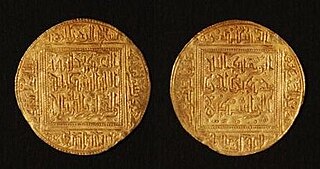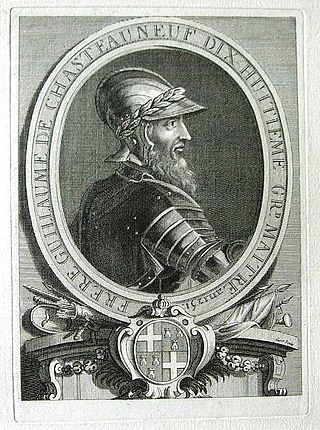Related Research Articles

Alphonse was the Count of Poitou from 1225 and Count of Toulouse from 1249. As count of Toulouse, he also governed the Marquisate of Provence.

Louis IX, also known as Saint Louis, was King of France from 1226 until his death in 1270. He is widely recognized as the most distinguished of the Direct Capetians. Following the death of his father, Louis VIII, he was crowned in Reims at the age of 12. His mother, Blanche of Castile, effectively ruled the kingdom as regent until he came of age and continued to serve as his trusted adviser until her death. During his formative years, Blanche successfully confronted rebellious vassals and championed the Capetian cause in the Albigensian Crusade, which had been ongoing for the past two decades.
Year 1250 (MCCL) was a common year starting on Saturday of the Julian calendar.

Year 1270 (MCCLXX) was a common year starting on Wednesday of the Julian calendar, the 1270th year of the Common Era (CE) and Anno Domini (AD) designations, the 270th year of the 2nd millennium, the 70th year of the 13th century, and the 1st year of the 1270s decade.

Philip III, called the Bold, was King of France from 1270 until his death in 1285. His father, Louis IX, died in Tunis during the Eighth Crusade. Philip, who was accompanying him, returned to France and was anointed king at Reims in 1271.

The Eighth Crusade was the second Crusade launched by Louis IX of France, this one against the Hafsid dynasty in Tunisia in 1270. It is also known as the Crusade of Louis IX Against Tunis or the Second Crusade of Louis. The Crusade did not see any significant fighting as Louis died of dysentery shortly after arriving on the shores of Tunisia. The Treaty of Tunis was negotiated between the Crusaders and the Hafsids. No changes in territory occurred, though there were commercial and some political rights granted to the Christians. The Crusaders withdrew back to Europe soon after.

The Seventh Crusade (1248–1254) was the first of the two Crusades led by Louis IX of France. Also known as the Crusade of Louis IX to the Holy Land, it aimed to reclaim the Holy Land by attacking Egypt, the main seat of Muslim power in the Near East. The Crusade was conducted in response to setbacks in the Kingdom of Jerusalem, beginning with the loss of the Holy City in 1244, and was preached by Innocent IV in conjunction with a crusade against emperor Frederick II, Baltic rebellions and Mongol incursions. After initial success, the crusade ended in defeat, with most of the army – including the king – captured by the Muslims.

The Hafsids were a Sunni Muslim dynasty of Berber descent who ruled Ifriqiya from 1229 to 1574.

The Battle of Fariskur was the last major battle of the Seventh Crusade. The battle was fought on 6 April 1250, between the Crusaders led by King Louis IX of France and Egyptian forces led by Turanshah of the Ayyubid dynasty.

The Crusades were a series of religious wars initiated, supported, and sometimes directed by the Christian Latin Church in the medieval period. The best known of these military expeditions are those to the Holy Land between 1095 and 1291 that had the objective of reconquering Jerusalem and its surrounding area from Muslim rule after the region had been conquered by the Rashidun Caliphate centuries earlier. Beginning with the First Crusade, which resulted in the conquest of Jerusalem in 1099, dozens of military campaigns were organised, providing a focal point of European history for centuries. Crusading declined rapidly after the 15th century.

The Battle of Mansurah was fought from 8 to 11 February 1250, between Crusaders led by Louis IX, King of France, and Ayyubid forces led by Sultana Shajar al-Durr, vizier Fakhr ad-Din ibn as-Shaikh, Faris ad-Din Aktai, Baibars al-Bunduqdari and Qutuz. It was fought in present-day Mansoura, Egypt. The Crusader force was enticed into entering the town where it was set upon by the Muslim force. The Crusaders withdrew in disorder to their encampment where they were besieged by the Muslims. The Crusaders broke-out and withdrew to Damietta in early April.

Muhammad I al-Mustansir was the second ruler of the Hafsid dynasty in Ifriqiya and the first to claim the title of Khalif. Al-Mustansir concluded a peace agreement to end the Eighth Crusade launched by Louis IX of France in 1270. Muhammad I al-Mustansir had been a vassal of the Kingdom of Sicily, but had shaken off his allegiance when King Manfred was overthrown by King Charles I.

The historiography of the Crusades is the study of history-writing and the written history, especially as an academic discipline, regarding the military expeditions initially undertaken by European Christians in the 11th, 12th, or 13th centuries to the Holy Land. This scope was later extended to include other campaigns initiated, supported, and sometimes directed by the Roman Catholic Church. The subject has involved competing and evolving interpretations since the capture of Jerusalem in 1099 until the present day. The religious idealism, use of martial force and pragmatic compromises made by those involved in crusading were controversial, both at the time and subsequently. Crusading was integral to Western European culture, with the ideas that shaped behaviour in the Late Middle Ages retaining currency beyond the 15th century in attitude rather than action.

John Tristan was a French prince of the Capetian dynasty. He was jure uxoris count of Nevers from 1265 and of Auxerre and Tonnerre from 1268. He was also in his own right Count of Valois and Crépy, as an appanages of the crown, from 1268.

Ottoman Tunisia, also known as the Regency of Tunis, refers to the Ottoman presence in Ifriqiya from the 16th to 19th centuries, when Tunis was officially integrated into the Ottoman Empire as the Eyalet of Tunis. The Ottoman presence in the Maghreb began with the takeover of Algiers in 1516 by the Ottoman Turkish corsair and beylerbey Aruj, eventually expanding across the entire region except for Morocco. The first Ottoman conquest of Tunis occurred in 1534 under the command of Khayr al-Din Barbarossa, the younger brother of Aruj, who was the Kapudan Pasha of the Ottoman Fleet during the reign of Suleiman the Magnificent. However, it was not until the final Ottoman reconquest of Tunis from Spain in 1574 that the Turks permanently acquired the former territories of Hafsid Tunisia, retaining it until the French occupation of Tunisia in 1881.

Guillaume de Chateauneuf was the nineteenth Grand Master of the Knights Hospitaller, serving first from 1242–1244 as the successor to Pierre de Vieille-Brioude. He was captured during the Battle of La Forbie in 1244, held hostage in Egypt and ransomed through the Sixth Crusade. During his captivity, his position was filled on an interim basis by Jean de Ronay. De Ronay died in 1250, and de Chateauneuf was released shortly thereafter. He was succeeded by Hugues de Revel.
This list of works on the history of the Crusades and their mainly Muslim opponents, provides a select bibliography of modern works that are frequently cited in books, papers and articles that discuss these "holy wars". Thousands of histories on these topics have been published between the 11th and 21st centuries; this page only lists modern works on the topic. Works included are referenced in the notes or bibliographies of scholarly secondary sources or journals. Included works are: published by an independent academic or notable non-governmental publisher; authored by an independent and notable subject matter expert; or have significant independent scholarly journal reviews.

This chronology presents the timeline of the Crusades from the beginning of the Third Crusade, first called for, in 1187 to the fall of Acre in 1291. This is keyed towards the major events of the Crusades to the Holy Land, but also includes those of the Reconquista, the Popular Crusades and the Northern Crusades.
References
- ↑ Riley-Smith, Jonathan (2005). The Crusades: A History. pp. 209–210.
- Al-Maqrizi, Al Selouk Leme'refatt Dewall al-Melouk, Dar al-kotob, Cairo 1997. English translation by Bohn, Henry G., The Road to Knowledge of the Return of Kings, Chronicles of the Crusades, AMS Press, 1969.
- Beebe, Bruce, "The English Baronage and the Crusade of 1270," in Bulletin of the Institute of Historical Research, vol. xlviii (118), November 1975, pp. 127–148.
- Lower, Michael (2018). The Tunis Crusade of 1270: A Mediterranean History. Oxford University Press.
- Narbaitz, Pierre (2007). Navarra o cuando los vascos tenían reyes. Tafalla: Editorial Txalaparta.
- Paterson, Linda (2003). "Lyric allusions to the crusades and the Holy Land." Colston Symposium.
- Richard, Jean. The Crusades, C.1071-c.1291, Cambridge University Press, 1999. ISBN 0-521-62566-1
- Riley-Smith, Jonathan (2005) [1987]. The Crusades: A History (2nd ed.). New Haven, Connecticut: Yale University Press. ISBN 978-0-8264-7270-0.
- Strayer, Joseph R. (1969). "The Crusades of Louis IX". In R. L. Wolff; H. W. Hazard (eds.). A History of the Crusades, Volume II: The Later Crusades (1189–1311). Madison, Wisconsin: University of Wisconsin Press. pp. 486–518.
- Throop, Palmer A., "Criticism of Papal Crusade Policy in Old French and Provençal." Speculum , Vol. 13, No. 4. (October, 1938), pp. 379–412.